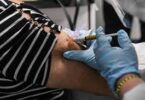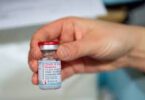Caitlin Owens
The first updated coronavirus vaccines — and likely the last one purchased by Uncle Sam — are about to become available across the U.S., and will ideally provide more targeted protection against the dominant strain that’s circulating.
Why it matters: Although COVID and its risks have become a routine part of life for most Americans, the virus is still killing around 400 Americans a day. Staying up to date on vaccines could minimize these deaths.
What’s happening: The updated vaccines will go through the regulatory approval process this coming week, and the shots are expected to become available soon after — likely the week after Labor Day, according to a senior Biden administration official.
- The federal government is expected to authorize them for everyone 12 and older, although only Pfizer’s shot will be available for children under 18.
- “When available, new boosters are expected to help provide greater protection against the currently circulating strains. We encourage all who are eligible to consider a booster,” FDA Commissioner Robert Califf tweeted Thursday.
The big picture: Being vaccinated and boosted is crucial for avoiding hospitalization and death, particularly for those with conditions that put them at high risk.
- But it’s unclear how well the retooled vaccines will protect against infection and transmission.
- Although the original vaccines initially offered a high level of protection against infection, they’re not nearly as effective against the Omicron variant. The question is whether a vaccine that’s matched to the strain in circulation — which the new ones are — will be significantly better.
Between the lines: Americans don’t seem to be very interested in boosters, at least not lately.
- Less than half of fully vaccinated Americans have received a first booster dose, per the CDC. Of people with a booster dose, only a third have received a second, although many Americans aren’t yet eligible.
- Among people 65 and older, who are at higher risk for severe disease, 71% have received a first booster shot, and 41% of those people have received a second.
The intrigue: The FDA has prioritized speed — which is necessary if the goal is to keep up with the virus’s mutations — over having all of the data on how the vaccines work in real life. Some experts warn that this risks dampening enthusiasm for the shot.
- The agency earlier this summer made the decision to target B.A.5, the strain that remains dominant in the U.S. today, as opposed to earlier Omicron strains.
- This means that Pfizer-BioNTech and Moderna have been able to update their vaccines remarkably quickly, but we don’t have complete real-world data on how they work in humans. Preclinical data suggests the shots elicit a strong neutralizing antibody response.
- The annual flu vaccine is updated using non-human data, so there’s a precedent for the FDA’s approach.
- “Bivalent and multivalent vaccines are very common and modifying a vaccine to include different virus strains often does not require a change in other ingredients. FDA has extensive experience with reviewing strain changes in vaccines, as is done with the annual flu vaccine,” Califf tweeted.
What they’re saying: “The FDA should be commended for wanting to take an aggressive, expedient approach,” Eric Topol, executive vice president of Scripps Research, wrote on Substack.
- “But we also need to acknowledge the uncertainties about efficacy and the response from the public,” he added.
What we’re watching: Peter Marks, the top FDA vaccine official, told the New York Times that the FDA may recommend that people who recently received a vaccine dose wait “a few months” before getting a new shot, and the CDC may address whether recently infected people should also wait.
- And in the longer-term, we never know when the next variant will take over, or how well the existing vaccines will work against it.
Courtesy: (Axios)






